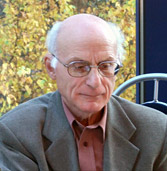
Electronic english version since 2022 |
The newspaper was founded in November 1957
| |
IN THE WAKE of the departed
| Gurgen M. Ter-Akopyan 11.10.1935 - 18.09.2024 |
 On 18 September, Gurgen M.Ter-Akopyan, Doctor of Physical and Mathematical Sciences, Professor, a chief researcher at the Flerov Laboratory of Nuclear Reactions, a renowned scientist that made a significant contribution to science, passed away.
On 18 September, Gurgen M.Ter-Akopyan, Doctor of Physical and Mathematical Sciences, Professor, a chief researcher at the Flerov Laboratory of Nuclear Reactions, a renowned scientist that made a significant contribution to science, passed away.
The range of Gurgen Ter-Akopyan's scientific interests was wide and varied - from studying the properties of transfermium elements, the synthesis of superheavy elements and the search for these elements in nature to research of the structure of nuclei at the boundaries of nucleon stability.
The entire scientific life of Gurgen M. Ter-Akopyan was united to the Joint Institute for Nuclear Research, where he had worked since 1958, after having graduated from the Physics and Mechanics Department of the Leningrad Polytechnic Institute. The list of scientific achievements of G.M.Ter-Akopyan in the Laboratory of Nuclear Reactions is extensive and impressive. In the early 1960s, a group of physicists from the Laboratory of Nuclear Reactions that included V.A.Karnaukhov, G.M.Ter-Akopyan, V.G.Subbotin and L.A.Petrov, discovered a new type of radioactive decay of nuclei - the emission of delayed protons. In 1962, the corresponding discovery was registered in the USSR under number 35. Further research on this topic was the basis of G.M.Ter-Akopyan's PhD thesis "Research on the proton decay of radioactive nuclei" that he defended in 1967.
In 1968, on the initiative of G.N.Flerov, search for superheavy elements in nature in the Laboratory of Nuclear Reactions was carried out. To meet this issue, a highly sensitive facility based on He-3 counters for registering multiple neutrons emitted during the fission of an atomic nucleus was developed in the Sector under his supervision. Based on the results of this research, in 1983, Gurgen Ter-Akopyan defended his doctoral thesis "Research on the synthesis and search for superheavy elements in nature".
In 1975, G.M.Ter-Akopyan was awarded the USSR State Prize in Science and Technology for a series of papers on the synthesis and investigation of the properties of atomic nuclei and the boundaries of nuclear stability. In the mid-1980s, under the supervision of G.M.Ter-Akopyan, the VASILISA kinematic separator was put into operation. Numerous experiments were implemented to study the properties of heavy and superheavy nuclei obtained in fusion reactions for a wide range of excitation energies and mass asymmetry in the input channels on this separator.
The idea of studying nuclear fission by registering multiple gamma quanta emitted by fission fragments was proposed by G.M.Ter-Akopyan and was first implemented in 1990. Experiments on studying spontaneous fission of CF with the use of a new technique that allowed registration of light charged particles and fission fragments in coincidence with gamma quanta, were carried out jointly with American colleagues at the GAMMASPHERA facility. The new technique allowed obtaining detailed data on the processes of binary and ternary fission of CF-252.
Under the supervision of G.M.Ter-Akopyan, a unique project of storage rings K4-K10 was developed in 1988-1992. The experience of this research allowed the staff of the Sector under the supervision of G.M.Ter-Akopyan to immediately develop the fragment-separator ACCULINNA, designed to implement experiments with radioactive beams. The facility was put into operation in 1996 and operates today. With the active engagement of G.M.Ter-Akopyan, a new fragment-separator ACCULINNA-2 was launched in 2018, where results of international standard were obtained in the field of light exotic nuclei.
Until the last days of his life, Professor G.M.Ter-Akopyan was actively engaged in addressing scientific tasks, devoted much time to teaching and educated a whole galaxy of specialists.
FLNR Directorate, friends, students and colleagues mourn the loss of a great scientist and remarkable person Gurgen M.Ter-Akopyan, and express deep condolences to his family and friends.